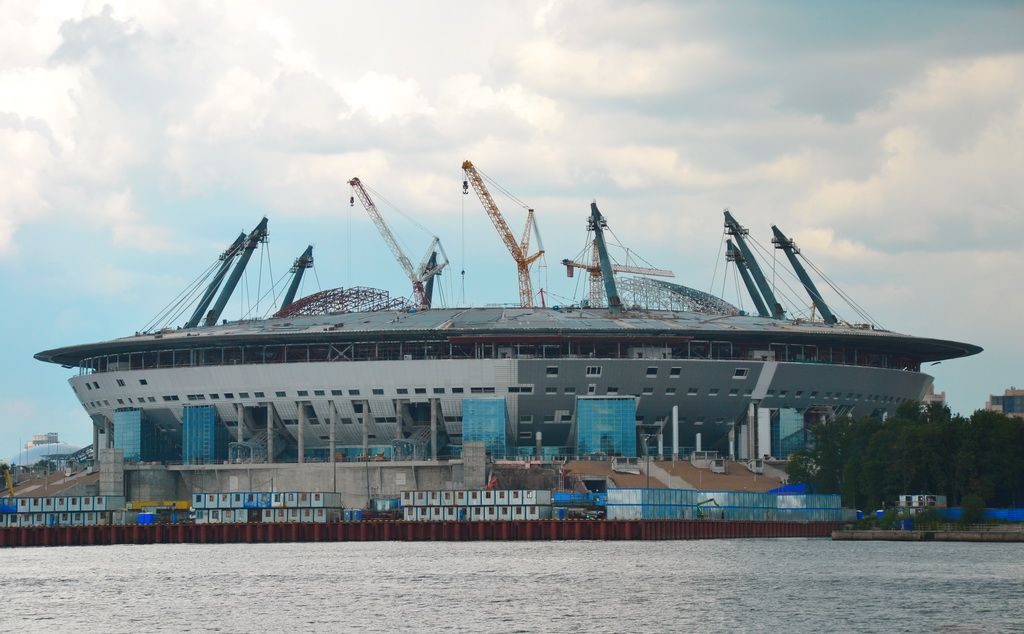The saga of the Krestovsky stadium (official name is the Saint Petersburg Stadium, also called Zenit Arena or Gazprom Arena, or Zenit stadium) projected to host FIFA World Cup 2018 and Confederations Cup 2017 seemed to be finally over, but it has recently continued as a FIFA commission discovered that a sliding playing field was unstable. Instead of drinking champagne, we decided to briefly overview the long and very unlucky story of the stadium which has already cost St. Petersburg citizens about $706 million and may cost even more.
On September, 11, Gazprom’s CEO Alexey Miller visited the Krestovsky stadium, local media reported. Gazprom is the owner of the FC Zenit St. Petersburg which will be managing the venue and playing there their home games. Mr Miller, a great fan of the Zenit, was reportedly dissatisfied with what he had seen. He didn’t say a word, but his face spoke for itself. For example, a VIP-restaurant has almost no windows and the height of the VIP-lounge is just 1.85 meters.
This story is the essence of the stadium’s construction process and the atmosphere surrounding it. Almost a decade of construction yielded a 68.000-seat arena which will likely need reconstructing and repairing just upon completion. The venue became a subject for bitter jokes and anecdotes among the city residents.
The stadium was designed by the late famous Japanese architect Kisho Kurokawa, it has the form of a spaceship, a sliding roof and a retractable playing field.
Initially, it was planned that the construction process would take just two years, from 2007 to 2009. Then, rather suddenly, Russia won the right to host the World Cup 2018, so it turned out that the venue needed some redesigning. Unusual design, all these pleasant features like the pitch and the roof coupled with lack of experience in implementing such projects as well as the Russian tradition to award large-scale contracts to companies close to the Kremlin, no matter if they are best qualified for a job, led to numerous delays. It was rescheduled to open in 2010, 2011, 2013, 2015, and at last in late 2016, and we hope that this time the dream finally comes true.
As years were passing by, FIFA was increasingly becoming nervous. The peak of the tension fell on the summer 2016, when the St. Petersburg’s government, who pays for the venue, expressed dissatisfaction with the job of the contractor, a company of Russian tycoon Oleg Deripaska. The conflict which could put under threat the fate of the World Cup’s matches in St. Petersburg, drew the attention of Russian President Vladimir Putin who angrily demanded the stadium be put into operation in time.
Then Sports Minister, later boosted to deputy Prime Minister, Vitaly Mutko would visit the arena every week and was personally involved into the process of controlling and negotiating between Mr Deripaska and the city government. Finally, the government replaced the Deripaska’s company.
To make things worse, regular FIFA inspections discovered a lot of technical flaws, for example, too narrow passages. The delegation of the FC Zenit after their visit set up a list of more than 1.000 (one thousand) flaws. While Mr Miller may be suffering from lack of windows in the VIP-restaurant, coaches of the Zenit will definitely be short of space and toilets since the room for coaches is designed only for one person and, surprisingly, has no toilets.
What’s not surprising is the fact that in September the Christian Orthodox Church together with some city government’s top-ranked representatives held a public prayer to ask the Lord to help with successful completion. The story went far beyond the football society of the country and fast became the subject for rather harsh Internet trolling.
Many city residents dubbed the venue «Shame-Arena» or «Bribe-Arena» which refers to the problem of corruption in Russia and the inefficiency of the federal government and presidency.
The initial price of 6.7 billion rubles skyrocketed to 43,8 billion rubles ($706 million). All this money has been taken out of the city’s budget, sometimes at the expense of social infrastructure such as hospitals and schools whose arrival was delayed due to the necessity to find additional funds to complete the arena.
So what’s going on right now? Well, Mr Mutko told the press last week that the problem of the unstable playing field would be solved and that there was «nothing unusual» with that. How much will the solution, which is to be found, cost? Anyway, it will surely not increase the overall costs significantly as any additional sum is nothing in comparison to the whole sum spent till this moment.
Continuation of the story here.
By the way, who is Mr Mutko? Let`s see how he is able to speak in English 🙂
Мутко: Лет'c ми спик фром май харт, ин инглиш от moscowmvn на Rutube.
P.S. Read our post about getting to the stadium here.
